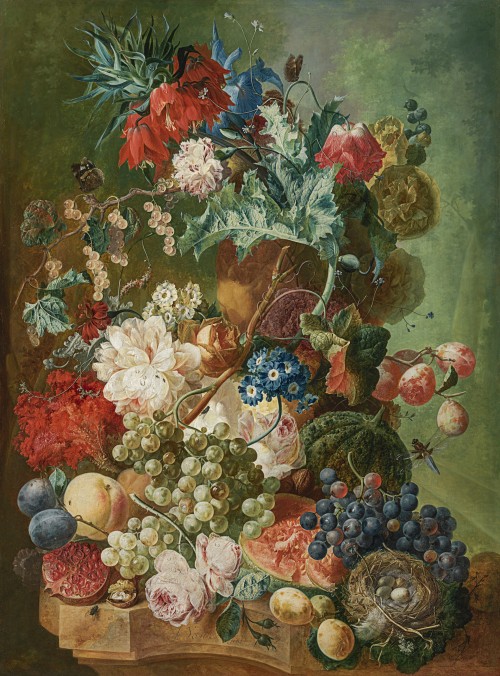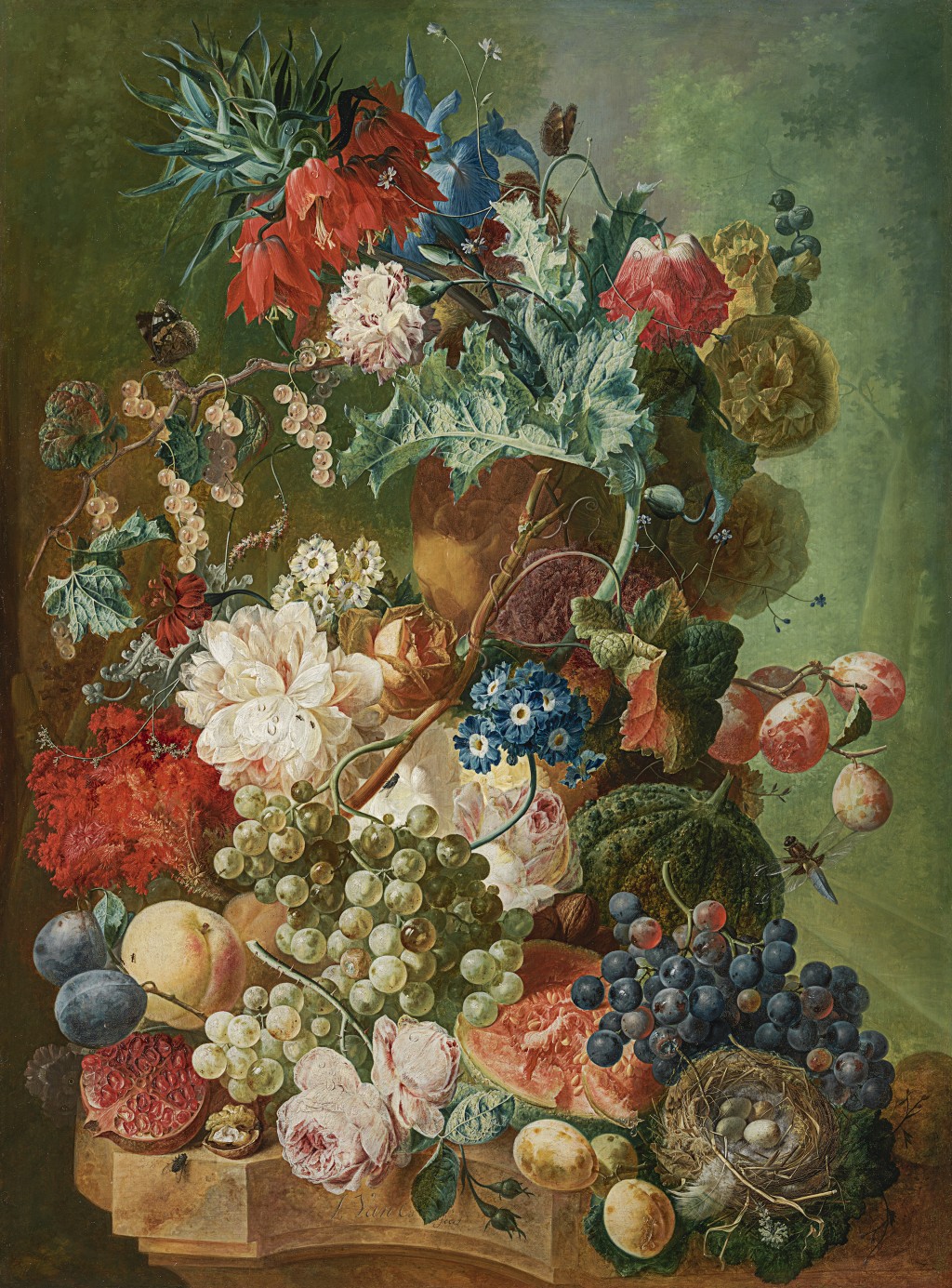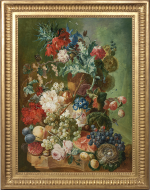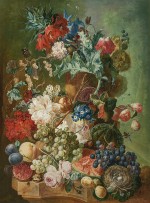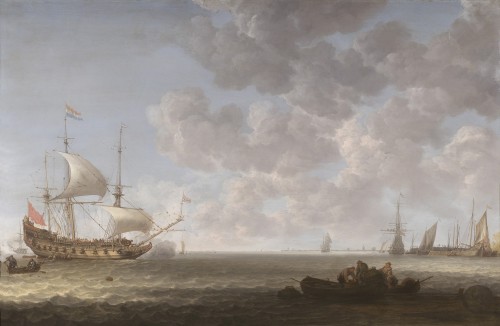JAN VAN OS
Middelharnis 1744 - 1808 The Hague
Ref: CC 126
Still life of roses, auriculas, an iris, Fritillaria imperialis, a poppy and other flowers in a terracotta vase, with fruit and a bird’s nest on a marble ledge
Signed lower left: J. Van Os fecit
Oil on panel: 31 1/8 x 22 ¾ in / 79.1 x 57.8 cm
Frame size: 38 x 30 in / 96.5 x 76.2 cm
Painted circa 1785
Provenance:
Private collection, Paris, acquired in the 1970s
Jan van Os was the successor to Jan van Huijsum (1682-1749) as a painter of opulent flower still lifes in the second half of the eighteenth century. He spent all of his career in The Hague, the seat of the Court. Van Os was influenced by van Huijsum in his light, rich palette and light backgrounds, which often have intimations of a parkland or forest setting, as in this work.
Van Os places his flowers in a terracotta vase with a high-relief design of playful putti, reflecting the taste for neoclassicism in Dutch interiors at the end of the eighteenth century. The composition ripples in a diagonal from top left to bottom right, bringing a sense of energy to the array of fruit and flowers. This is underlined by a complex weaving of dark and light elements. The hazy forest landscape at background right is pale green, contrasting with the shadowed vase and melon, which in turn push into prominence the sunlit poppy leaf, auriculas and branch of plums. By contrast, the cascade of spotlit flowers on the left, including the pink peony, roses and red cockscomb (celosia) is set against a darker forest background.
Typical of van Os is the placing of a prominent, brightly-coloured flower at the top of the bouquet, in this case a stem of scarlet Fritillaria imperialis, a showy plant native to Anatolia, introduced by Carolus Clusius to his Leiden botanic garden in the sixteenth century. Adjacent is an opium poppy; van Os makes brilliant play of its complex, twisting leaves, scattered with droplets of dew. The selection of flowers is characteristic of eighteenth century taste: the bouquet lacks tulips, which would have been prominent in seventeenth century flower paintings. At the centre of the bouquet are auriculas, an Alpine plant which became fashionable in the eighteenth century, with competition to develop ever more colours and markings.
Like van Huijsum, van Os pays exquisite attention to botanical accuracy and the textures of flowers and fruit. The grapes and whitecurrants shine as if lit from within. Another favourite motif is the bird’s nest in the foreground right of the painting, with a perfect, translucent feather caught within its weave. Several insects are present, including two butterflies, a dragonfly and a fly perched upon the marble ledge, a brilliant example of trompe l’oeil. Eighteenth century Dutch still lifes are less likely to contain symbolism than ones from the previous century, but this work does display the Four Elements: Earth (the marble ledge, fruit and flowers); Air (the insects); Fire (the terracotta vase) and Water (the dewdrops). Its colourful abundance reflects the Dutch genius for horticulture and agriculture and the Dutch élite’s frank enjoyment of the good things in life.
JAN VAN OS
Middelharnis 1744 - 1808 The Hague
Jan van Os may be considered as the most important painter of still life from the Dutch eighteenth century after Jan van Huijsum (1682-1749) - the ‘patriarch’ of still-life painting for this period. Van Os was born in the village of Middelharnis in the province of Zeeland, but when still young, he moved to The Hague and remained there for the rest of his life. In The Hague, he trained under the renowned draughtsman, watercolourist and painter Aert Schouman (1710-1792) in Dordrecht. Jan van Os did not join The Hague artist’s guild, the Confrerie Pictura, until 1773, at the age of twenty-nine, but earlier work by his hand is known. He dated a few works between 1765 and In 1775 he married Susanna de la Croix (1755-1789), draughtswoman and daughter of the portrait painter Pierre Frédric de la Croix (1709-1782).
From 1773 van Os regularly sent paintings to London for exhibition at the Society of Artists and continued to do so until that institution’s closure in 1791. In this way, many of his works must have ended up in British collections early on. One may conclude from the large number of works by Jan van Os that have come back onto the market over the years from English private collections, that their popularity there was substantial. However, also elsewhere in Europe his work was held in high esteem. As early as 1784, in the catalogue of the Paris sale of the collection of the Comte de Vaudreuil, it was observed that ‘Amateurs…justly accord his work the highest consideration’.
Apart from still lifes of flowers and of fruit, Jan van Os painted landscapes – mainly river landscapes and coastal scenes, which stylistically lean quite heavily on Dutch seventeenth-century tradition, much more so than his still lifes do. Moreover, van Os’s manner of rendering ‘waterscapes’ was a typical Dutch eighteenth-century one, representing still and peaceful waters, reflecting the somewhat languid atmosphere of the period. In comparison with those images, van Os’s still lifes are lively and vigorous.
Jan van Os taught three of his children to paint: the still life artists Georgius Jacobus Johannes van Os (1782-1861) and Maria Margaretha (1779-1862), as well as Pieter Gerardus (1776-1839), who specialised in landscapes and animal paintings.
The work of Jan van Os is represented in the Museum Bredius, The Hague; the Kröller-Müller Museum, Otterloo; the Alte Pinakothek, Munich; the Louvre, Paris; the Fitzwilliam Museum, Cambridge; the Speed Art Museum, Louisville and the Art Gallery of South Australia, Adelaide.

